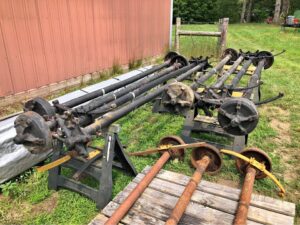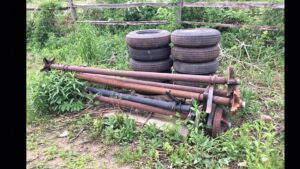Did you know that axles and hitches are the unsung heroes behind the smooth transportation of mobile homes? These crucial components play a vital role in ensuring your home arrives safely at its destination. Without them, moving a mobile home would be nearly impossible.
Mobile Home Axles and Hitches
Axles provide the necessary support and stability, allowing your home to roll smoothly down the road. Meanwhile, hitches serve as the connection between your mobile home and the towing vehicle, ensuring a secure attachment during transport.

Working together in perfect harmony, axles and hitches form a dynamic duo that keeps your mobile home on track. As a mobile home owner, it’s essential to have a basic understanding of these components to ensure their proper maintenance and operation.
So, whether you’re planning to relocate or simply want to expand your knowledge about your beloved dwelling, let’s delve into the world of axles and hitches for mobile homes. Get ready to discover how these unsung heroes make all the difference!
Explaining Mobile Home Transport: Wheels and Towing Hitch Removal
Process of removing wheels for mobile home transport
One crucial step is the removal of its wheels. This process ensures that the home can be safely moved from one location to another without any complications. Removing the wheels involves several steps, starting with securing the home and preparing it for transportation.
To begin, the mobile home needs to be placed on sturdy supports such as jacks or blocks. This helps in stabilizing the structure during the wheel removal process. Once properly supported, each wheel can be taken off individually by loosening the lug nuts using an appropriate wrench. It is important to note that safety precautions should always be followed, such as wearing protective gear and ensuring that all equipment used is in good working condition.
Importance of removing towing hitch before moving a mobile home
In addition to removing the wheels, detaching the towing hitch is equally essential when transporting a mobile home. The towing hitch connects the home to a vehicle for towing purposes. However, leaving it attached during transportation can pose significant risks and limitations.

By removing the towing hitch, potential damage caused by excessive movement or swaying while on the road can be avoided. Moreover, it allows for better maneuverability when navigating tight spaces or turns during transportation. Separating the hitch from the mobile home prevents any unnecessary strain on both structures and ensures a smoother journey.
Steps involved in safely removing wheels from a mobile home
Securely position and support the mobile home using jacks or blocks.
Loosen all lug nuts on each wheel using an appropriate wrench.
Lift each wheel carefully off its axle once all lug nuts are loosened.
Store removed wheels in a safe location until they are needed again.
Following these steps ensures that wheels are removed safely without causing any damage to either the axles or tires of your mobile home. It is crucial to exercise caution and pay attention to every detail during this process.
Benefits of detaching the towing hitch during transportation
Detaching the towing hitch offers several benefits when transporting a mobile home. These advantages include:
Improved maneuverability: Without the hitch, it becomes easier to navigate through narrow spaces or make sharp turns.
Reduced risk of damage: Separating the hitch minimizes the likelihood of structural damage caused by excessive movement or swaying.
Better weight distribution: By removing the hitch, weight distribution can be optimized for safer transportation.
Enhanced stability: Without the added weight and potential strain from the hitch, the mobile home remains more stable throughout the journey.
Different Sizes of Axles for Mobile Homes
One crucial component that ensures safe and smooth transportation is the axle. The size of the axle plays a significant role in determining how well a mobile home can be towed.

Variations in axle sizes based on mobile home weight and size
Mobile homes come in various weights and sizes, ranging from small trailers to larger manufactured homes. As such, it’s essential to have different axle sizes to accommodate these variations. The weight and size of a mobile home directly impact its stability during transport. Heavier and larger homes require sturdier axles to handle the load effectively.
Common axle sizes used in the industry for different types of homes
In the industry, several standard axle sizes are commonly used for different types of mobile homes. These sizes are determined based on extensive research and testing to ensure optimal performance. Here are some examples:
Single Axle: Typically found on smaller trailers or lightweight mobile homes.
Tandem Axle: Used for mid-sized or moderately heavy mobile homes.
Triple Axle: Suitable for larger manufactured homes with substantial weight.
These standard sizes provide a baseline for selecting an appropriate axle based on the specific needs of a mobile home.
Factors to consider when determining the appropriate axle size
Choosing the right axle size involves considering several factors beyond just weight and size. It’s important to evaluate other variables that can affect towing safety:
Load Distribution: Properly distributing the weight inside a mobile home is crucial for balanced towing. Uneven distribution can strain axles and lead to instability during transport.
Road Conditions: Consider where you plan to transport your mobile home. Different road conditions may require stronger axles capable of handling rough terrains or uneven surfaces.
Towing Vehicle Capacity: The towing capacity of the vehicle used to transport the mobile home should align with the axle size. Overloading a smaller axle can put excessive strain on both the axle and the towing vehicle.
Importance of matching the correct axle size to ensure safe transport
Matching the correct axle size is paramount to ensure safe transportation of mobile homes. Using an undersized or mismatched axle can lead to several issues, including:
Excessive wear and tear on axles, tires, and suspension components.
Reduced stability and increased risk of accidents during transit.
Increased fuel consumption due to added stress on the towing vehicle.
By selecting an appropriate axle size that aligns with the weight, size, load distribution, road conditions, and towing vehicle capacity, you can significantly enhance safety while transporting your mobile home.

Different Sizes of Hitches for Mobile Homes
Selecting the right hitch size is crucial. Various hitch sizes are available to accommodate different types of trailers and ensure a safe and secure journey.
Factors influencing the choice of hitch size for a specific mobile home
Choosing the correct hitch size depends on several factors that need to be taken into consideration. One important factor is the type of trailer being towed. Different trailers have varying tongue weights and widths, which impact the selection process. Considering whether you will be towing oversize loads or not is vital as it affects your choice of hitch size.

Another crucial aspect is understanding your vehicle’s towing capacity. Every vehicle has a maximum weight it can safely tow, and exceeding this limit can lead to dangerous situations on the road. Therefore, it is essential to match your trailer’s tongue weight with your vehicle’s hitch capacity.
Compatibility between trailer tongue weight and hitch capacity
The compatibility between trailer tongue weight and hitch capacity plays a significant role in determining which size of hitch you should use for your mobile home. The tongue weight refers to the downward force exerted by the trailer onto the hitch ball. It is crucial to select a hitch with an appropriate weight rating that matches or exceeds your trailer’s tongue weight.
If you choose a smaller-sized hitch than what is required for your mobile home, it may lead to instability during towing, causing swaying or even detachment from your vehicle. On the other hand, using an oversized hitch may result in unnecessary added weight and reduced maneuverability.
To ensure compatibility between trailer tongue weight and hitch capacity, here are some options based on different sizes:
-
Class I hitches: Suitable for small trailers with lighter loads such as utility trailers or bike racks.
-
Class II hitches: Ideal for mid-sized trailers, including small campers and boats.
-
Class III hitches: Designed for larger trailers like RVs or horse trailers.
-
Fifth-wheel hitches: Specifically used for heavy-duty towing, commonly seen with large recreational vehicles (RVs) or livestock trailers.
Understanding the importance of selecting the right hitch size
Selecting the appropriate hitch size is crucial for maintaining safety on the road. Using an incorrectly sized hitch can lead to accidents, damage to your vehicle or trailer, and potential harm to yourself and others. It is essential to understand that a one-size-fits-all approach does not apply.
By carefully considering factors such as trailer type, tongue weight, and hitch capacity, you can ensure a smooth towing experience without compromising safety. Taking the time to research and consult professionals in the field will help you make an informed decision regarding which hitch size is best suited for your specific mobile home.
Cost of Moving a Mobile Home in 2023
Moving a mobile home can be a complex and costly process. Whether you’re relocating to a new neighborhood or across the country, it’s essential to understand the average cost estimates associated with this endeavor. Several factors influence the overall expense, including distance, permits, labor, and whether you choose to hire professional movers or opt for a DIY approach.
Current Average Cost Estimates
When budgeting for moving your mobile home in 2023, it’s crucial to have an idea of the potential expenses involved. On average, moving a mobile home within a local area can range from $1,000 to $5,000. However, long-distance moves can significantly increase these costs due to additional logistics and transportation requirements.
The size and weight of your mobile home also impact the overall expense. Smaller homes typically incur lower moving costs compared to larger ones. Specialized equipment such as axles and hitches may be required during transportation, adding extra charges.
Factors Affecting the Cost
Several factors come into play when determining the cost of moving a mobile home. Understanding these elements will help you plan your budget more effectively:
-
Distance: The farther you need to move your mobile home, the higher the transportation costs will be. Long-distance moves require careful planning and coordination with professional movers or self-haul options.
-
Permits: Moving a mobile home often involves obtaining permits from local authorities. These permits ensure compliance with regulations regarding road safety and infrastructure protection. Permit fees vary depending on location but should be factored into your overall budget.
-
Labor: Hiring professionals versus doing it yourself is another significant factor affecting costs. While hiring experts might seem expensive upfront, their experience ensures efficient handling of the entire process—saving you time and potential damage expenses.
Comparison between DIY Moves vs. Professional Movers
Deciding whether to undertake a DIY move or hire professional movers can be challenging. Consider the following points when making your decision:
-
DIY Moves:
-
Pros: Cost savings, flexibility in scheduling, and hands-on control.
-
Cons: Limited expertise, potential for damage or accidents, and increased personal effort.
-
-
Professional Movers:
-
Pros: Expertise in handling mobile homes, efficient and insured transportation, and reduced physical exertion.
-
Cons: Higher upfront costs compared to a DIY approach.
-
Additional Expenses to Consider
Apart from the main moving costs, there are several other expenses to consider when budgeting for a mobile home relocation:
-
Site Preparation: Before moving your mobile home onto a new site, you may need to prepare the land by clearing debris or leveling the ground. These tasks often involve additional charges.
-
Utility Disconnection and Reconnection: Disconnecting utilities at your current location and reconnecting them at the new site may incur fees from service providers.
-
Insurance Coverage: It’s crucial to ensure that your mobile home is adequately covered during transportation. Acquiring insurance coverage safeguards against any unforeseen damages that may occur during transit.
-
Storage Costs: If there’s a time gap between moving out of your current location and settling into the new one, you might need temporary storage for your mobile home. Renting storage space adds an extra expense to consider.
Evaluating the Cost Factors for Moving a Mobile Home
Moving a mobile home can be an expensive endeavor, and it’s important to understand the various cost factors involved. From distance and permits to labor, equipment, and insurance, each element plays a significant role in determining the overall expenses.
Distance Matters: Mobile Home Axles & Hitches
The distance between your current location and the new destination is one of the primary factors that influence the cost of moving a mobile home. Longer distances require more fuel, time, and resources. Moving companies may charge extra fees for long-distance moves due to increased wear and tear on their vehicles. It’s crucial to consider this aspect when planning your relocation.
Permits, Fees, and Regulations: Mobile Home Axles and Hitches
Before embarking on your mobile home move, it’s essential to research and obtain all necessary permits and comply with local regulations. Permit fees can vary significantly depending on your location. Some areas may also have specific requirements regarding road closures or escorts during transportation. Failing to adhere to these regulations can result in fines or delays in your move.
Labor and Equipment Costs
Moving a mobile home requires skilled laborers who specialize in handling such tasks. The size and complexity of your housing unit will impact labor costs. Specialized equipment like cranes or heavy-duty trucks may be necessary for certain moves, adding to the overall expenses.
To minimize labor costs, you could consider hiring local contractors for certain aspects of the move instead of relying solely on professional movers. However, ensure that any hired help has experience in moving modular homes to avoid potential damage during transit.
Insurance Coverage
While no one wants accidents or damages during a move, it’s crucial to be prepared for any unforeseen circumstances by having appropriate insurance coverage. Moving insurance provides financial protection against potential damages incurred during transportation. The cost of insurance will depend on the value of your mobile home and the coverage options you choose.
If you are looking for insurance for your mobile home check out our page: Mobile Home Insurance
Obtaining Accurate Quotes
To ensure you have a clear understanding of the costs involved, it’s essential to obtain accurate quotes from multiple movers. This allows you to compare prices, services offered, and any additional fees or charges. By doing so, you can make an informed decision while considering your budget and specific requirements.
Minimizing expenses while ensuring a safe mobile home move requires careful planning and consideration of all cost factors involved. By taking into account distance, permits, labor, equipment, and insurance coverage, you can navigate the process more effectively. Remember to gather multiple quotes to find the best option for your needs. With proper preparation and research, you can successfully relocate your modular or manufactured housing unit without breaking the bank.
Safety Precautions during Mobile Home Transportation
Moving a mobile home can be a complex and challenging process. Ensuring the safety of both the home itself and those involved in its transportation is of utmost importance. By following essential safety measures, securing the home properly, maintaining stability and balance while on the road, and taking precautions in adverse weather conditions or challenging terrains, you can ensure a smooth and secure journey for your mobile home.
Essential Safety Measures to Follow when Moving a Mobile Home
Transporting a mobile home requires careful planning and adherence to safety guidelines. Before embarking on this endeavor, it is crucial to conduct thorough inspections of both the home and the transport equipment. This includes checking the axles, hitches, tires, brakes, lights, and any other components relevant to safe transportation.
Furthermore, it is advisable to hire professional mobile home movers who are experienced in handling such tasks. These experts possess the necessary knowledge and expertise to navigate potential challenges that may arise during transportation.
Importance of Securing the Home Properly to Prevent Damage During Transit
Securing your mobile home adequately is vital to prevent damage during transit. Failing to do so can result in structural issues or even complete loss of the property. To ensure proper security:
-
Utilize sturdy straps or chains: Fasten these tightly around the axles or frame of the mobile home.
-
Use appropriate fasteners: Employ heavy-duty bolts or screws when attaching any loose items within the house.
-
Reinforce windows and doors: Protect vulnerable areas by boarding them up securely.
-
Secure appliances: Make sure all appliances inside are well-anchored or disconnected before transportation.
By implementing these measures, you significantly reduce the risk of damage caused by shifting objects or unforeseen circumstances during transit.
Tips for Ensuring Stability and Balance While on The Road
Maintaining stability and balance throughout your journey is crucial for both your safety as well as the integrity of the mobile home. Consider the following tips:
-
Distribute weight evenly: Ensure that heavy items are evenly distributed within the home to avoid tilting or leaning during transportation.
-
Check tire pressure: Properly inflated tires contribute to stability on the road, so regularly inspect and maintain them.
-
Drive cautiously: Adhere to speed limits and take turns slowly and smoothly to minimize any destabilizing forces acting on the mobile home.
By adhering to these guidelines, you can enhance stability and balance, reducing the risk of accidents or damage while in transit.
Precautions to Take in Adverse Weather Conditions or Challenging Terrains
Adverse weather conditions and challenging terrains can significantly impact mobile home transportation. To mitigate potential risks:
-
Monitor weather forecasts: Stay informed about upcoming weather conditions along your route and plan accordingly.
-
Use escort vehicles: In some cases, it may be necessary to have escort vehicles accompany your mobile home for added safety and guidance.
-
Obtain proper permits and insurance coverage: Ensure you have obtained all required permits for transporting a mobile home, as well as comprehensive insurance coverage that protects against potential damages.
Adhering to regulations specific to your area is crucial when navigating adverse weather conditions or challenging terrains successfully.
Mobile Home Axles and Hitches: Conclusion
In conclusion, navigating axles and hitches for your mobile home is essential for a smooth and safe transportation process. Understanding the different sizes of axles and hitches, as well as the cost factors involved in moving a mobile home, will help you make informed decisions. Safety precautions should always be taken during transport to ensure the well-being of your home.
To summarize, here are the key points to remember:
-
Mobile home transport involves removing wheels and towing hitches.
-
Different sizes of axles are available for mobile homes.
-
Different sizes of hitches are also available to suit your specific needs.
-
The cost of moving a mobile home can vary depending on various factors.
-
Evaluating these cost factors will help you plan your budget effectively.
-
Safety precautions must be followed during transportation to prevent any damage.
Now that you have a better understanding of axles and hitches for mobile homes, it’s time to take action! If you’re planning to move your mobile home, consult with professionals who specialize in this field. They can provide expert advice and assistance throughout the process.
Remember, ensuring the safety and proper transportation of your mobile home is crucial. Don’t hesitate to reach out to experienced movers who can handle this task efficiently.
Mobile Home Axles & Hitches: FAQs
Can I remove the wheels from my mobile home myself?
It is recommended to seek professional assistance when removing wheels from a mobile home due to safety concerns and technical expertise required.
How do I determine the right size axle for my mobile home?
The size of the axle needed depends on various factors such as the weight and dimensions of your mobile home. Consulting with professionals or referring to manufacturer specifications can help determine the appropriate size.
Are there different types of hitches for mobile homes?
Yes, there are various types of hitches available based on towing capacity and compatibility with different vehicles. It’s important to choose a hitch that matches your specific requirements.
What are some cost factors to consider when moving a mobile home?
Factors such as distance, permits, transportation equipment, and additional services required can influence the overall cost of moving a mobile home. Obtaining quotes from multiple movers and discussing these factors will help you estimate the expenses accurately.
How can I ensure the safety of my mobile home during transportation?
Taking precautions such as securing loose items, disconnecting utilities, and using professional movers who specialize in mobile home transport will help ensure the safety of your home during transportation.
You might also be interested i our articles:

